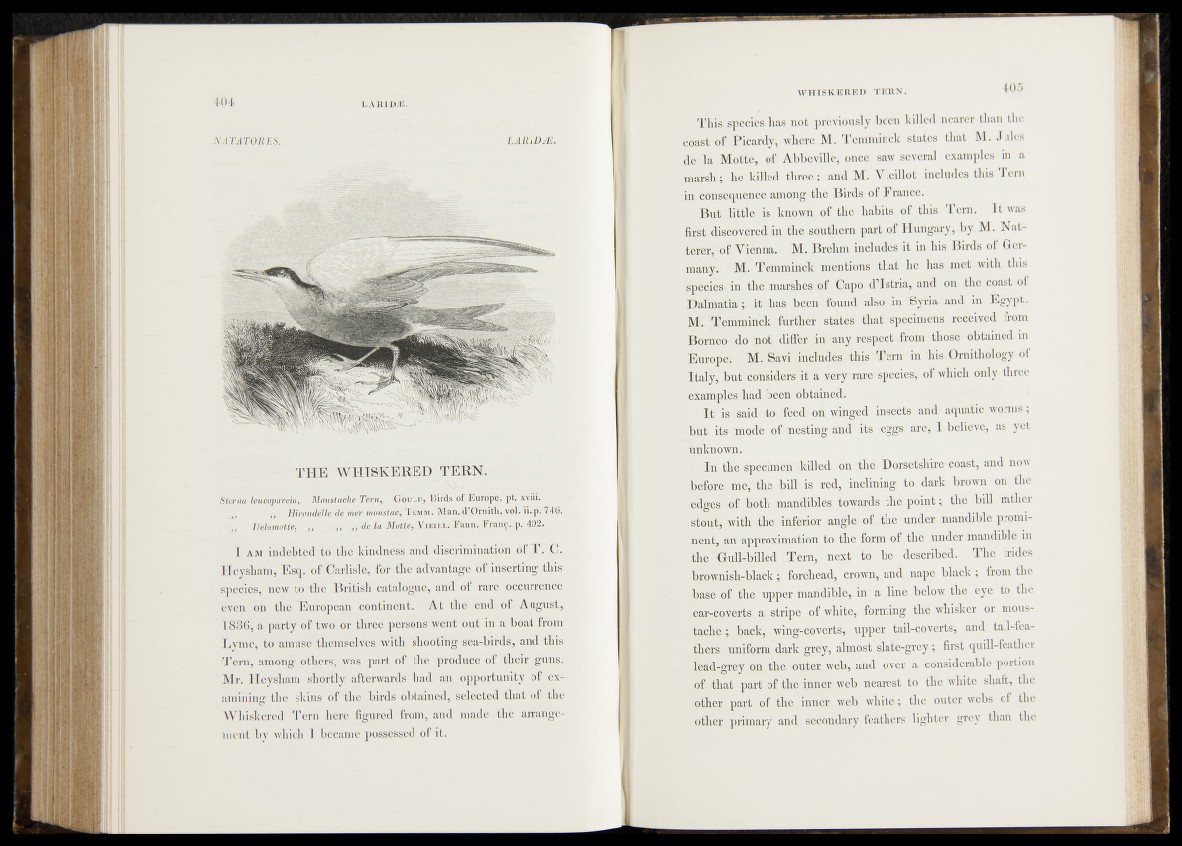
NATATORES. —
T H E W H ISK E R ED T ERN .
Sterna leucopareia, Moustache Tern, : Góul&, Bir'di'df EüropeipfT
^ ^ - ,~H h yn ie lleK'de mer mouefair, I emm. Man. d!Ornith. VÓltljl-p. 746.
,, Delamotte, „ ,,,deJa Mo^te, Vieill. Eaun. Fr-an£.,p., 4 0 ||.^ .1
I am indebted tó the kin-dnéss and discrimination óf T. C.
Heysham, Esq., of Carlisle, for the advantage of inserting this
species, new to the British catalogue, and of rare occurrence
even on the European continent. At thët end of August,
1836, a party of twó or three persons went out in a boat from
Lyme, to amuse themselves with ‘shöó'ting sea-birds, and this
Tern, among others, was part of thé producè óf their guns.
Mr. Heysham shortly afterwards had an ^opportunity of. examining
the shins of the birds obtained, selected that of the
Whiskered Tern here figured from, and made the arrangement
by which I became possessed of it.
This species has not previously been killed nearer than the
coast of Picardy, where M. Temminck states that M. Jules
de la Motte, of Abbeville, once saw several examples in a
marsh; he hilled three; and M. Yieillot includes this Tern
in consequence among the Birds of France.
But little is hnowp, of the habits of this Tern. I t was
first discovered in the southern part of Hungary, by M. Nat-
terer,:'of Vienna. M. Brehm includes it in his Birds of Germany,
M. Temminck mentions that he has met with this
species in j&ffi marshes, of Capo d’Istria, and on the coast of
Dalmatia; it -lias been found also-in Syria and in Egypt.
M: Temminck further stages that specimens received from
Borneo do not differ in any respect from those ■ obtained in
Europe. M. Savi .includes this Tern in his Ornithology of
Italy, but considers it a very rare species, of which only three
examples had been obtained.
It; is said to feed on winged insects and aquatic worms;
bii$ its mode of nesting and its eggs are, I believe, as yet
unknown.
In the specimen killed on the Dorsetshire coast, and now
before me, the bill is red, inclining to dark brown on the
edges of both' mandibles towards the point; the bill rather
stout, with the inferior angle of the under mandible prominent,
an approximation to the form of the under mandible in
the Gull-billed Tern, next to be described. The irides
brownish-black; forehead, crown* and nape black ; from the
base of the upper mandible, in a line below the eye to the
ear-coverts a stripe of white, forming the whisker or moustache
; back, wing-coverts, upper tail-coverts, and tail-feathers
uniform dark grey, almost slate-grey; first quill-feather
lead-grey on the outer web, and over a considerable portion
pf that part of the inner web nearest to the white shaft, the
other part of the innei web white ;. the outer webs of the
other primary and secondary feathers lighter grey than the